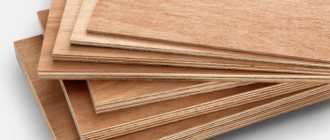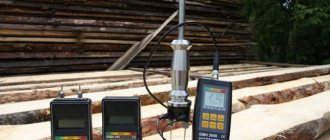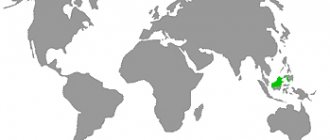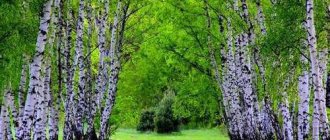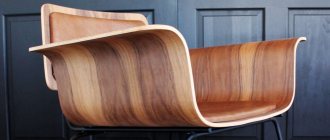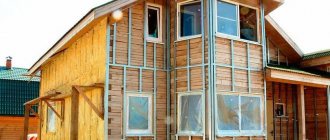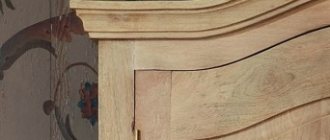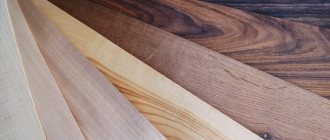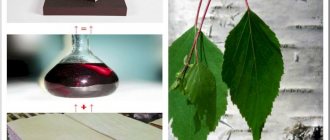Modern furniture manufacturers offer a variety of options for making custom-made furniture. And one of the issues that you need to decide is the choice of material. Today we will compare the advantages and disadvantages of the most popular furniture materials - Chipboard, MDF and solid wood.
Furniture made from chipboard and MDF, in comparison with furniture made from solid wood, has a seemingly undeniable advantage - a more affordable price. But what exactly will this mean once you start using this furniture?
Chipboard
Production technology: created by pressing sawdust with formaldehyde resins. Standard thickness is up to 25 mm.
| + Cheap | — Contains harmful resins |
| + High strength (at the level of solid wood) | - Difficult to repair |
In the production of chipboard, two types of resins are used - E1 and E2. E1 is less harmful than E2 and can be used to create children's furniture.
Chipboard (chipboard) sheets
What is the difference between chipboard, fiberboard and MDF?
Fibreboard is made by heat pressing small wood fibers . They mainly produce sheets of small thickness - 3 or 6 mm. They are used for the back walls of cabinet furniture, the bottoms of drawers, as separate elements of the frame of upholstered furniture, etc. Thus, at least in carpentry, fiberboard is an auxiliary material for the manufacture of unloaded parts.
The raw material for the material is wood fiber. In the production of soft fiberboards, a binder is usually not used - its functions are performed by lignin (a natural component of wood), which exhibits adhesive properties when exposed to high temperatures. Modifiers added to wood pulp during the production of fiberboard are limited, for the most part, to paraffin, rosin and synthetic resins. Their task is to make the material less susceptible to moisture. Separately, we note that many types of fiberboard still contain formaldehyde resins as a binder. Such materials are divided into the following formaldehyde emission classes: E0.5 / E1 / E2 .
Fiberboard does not withstand severe bending loads and breaks easily. The slabs cannot be sanded, do not hold fasteners well, are not moisture resistant, and are easily damaged (especially the edges). Fibreboard is produced by wet and dry methods. Sheets made using the wet process (also known as the Mason method) have only one smooth side, the other is textured. Wet technology is used to produce thin slabs (3-5 mm). Dry-processed boards remain smooth on both sides. This technology is used to produce thick fiberboard.
Solid and semi-solid types of fiberboard have a thickness from 2 to 10 mm. Soft types of slabs - from 8 to 16 mm. Thick fibreboards are used mostly for construction needs: for floor coverings and wall insulation, construction of lightweight partitions, etc. Their porous structure retains a lot of air and serves as an excellent heat insulator. Thin slabs (3-6 mm) are used for unloaded furniture elements (back walls, partitions, bottoms), as a basis for gluing veneer, as a material for the manufacture of budget laminate boards, for door trim, etc.
Perforated fiberboard sheet is an excellent solution for hanging tools. We described one way to implement this idea here:
Compact cabinet with great capabilities. Wall mounted tool box project.
What is HDF?
This is a high-tech type of fibreboard. The material is characterized by increased density and the absence of harmful formaldehyde-based binding components. HDF is made in the form of thin boards with a thickness of 3 or 4 mm. This material has gained the greatest popularity as the basis for the production of laminate flooring and veneered parquet.
HDF panels are made from steam-opened fibers, pressed under high pressure and at high temperatures. The result is dense and homogeneous slabs. The gluing of wood fibers occurs without the introduction of additional binders. These functions are performed by lignin, which is contained in wood and produces natural gluten when exposed to high temperatures. The density of the material exceeds that of MDF, reaching 1100 kg/m3. During the manufacturing process, HDF panels are additionally impregnated with oil. Polymerized oil forms a stable hydrophobic barrier in the structure of the board, protecting the material from moisture. At the same time, the hardness and impact resistance of the surface increases.
Along with chipboard, MDF and fiberboard, the “big four” wood-based panels include OSB (oriented strand board). This material is also made from recycled materials - large thin wood chips. In an OSB sheet they are laid in three to four layers with alternating orientation (longitudinal and transverse), which ensures high fracture strength. Various types of resins are used as binding components in the production of such boards, incl. having high toxicity (releasing formaldehyde and methanol). OSB boards are not used for making furniture, but are mostly used in construction.
laminated chipboard
Production technology: the same as chipboard, but additionally finished with a polymer film.
| Advantages: | Flaws: |
| + High strength | — Contains harmful resins |
| + Moisture resistance | — More expensive than chipboard |
| + Protection from high temperatures | -Difficult to repair |
Among other advantages, laminated chipboard perfectly imitates a wooden surface
Where are the materials used?
Plywood has a wide range of applications. It is used:
- In construction. It is used to cover buildings inside and outside. Plywood sheets are used to level surfaces and make strong partitions. Laminated plywood is often used as formwork material.
- In transport production. Laminated and flame retardant plywood is suitable for cladding carriages, buses and trucks. You can buy it from us at a low price - we have sheets of various thicknesses and sizes in our warehouse.
- In shipbuilding and aircraft construction. Aviation and bakelite grades of plywood are used for the construction of aircraft and ships.
- In furniture production, creativity, packaging production, etc.
MDF is not widely used. Typically, furniture facades, interior doors, and wall panels are made from these slabs. Because they absorb sound well, they are also used to make speaker systems.
The scope of application of MDF and plywood overlaps in the production of furniture. In other cases, there is no choice between these materials. What is furniture made from? Since only FC sheets, which are less moisture resistant, are suitable for interior spaces, it is better to make kitchen facades from MDF. Plywood is more suitable for the production of cabinets, shelves and racks, tables, chairs. For these purposes, it is better to use veneered products, which look like solid wood.
Fiberboard
Production technology: created from steamed and compressed wood dust. Standard thickness is from 2.5 to 12 mm.
| Advantages: | Flaws: |
| + Very low price | — Low strength |
| + The fiberboard composition includes paraffin and rosin. increasing the moisture resistance of the material |
When purchasing products made from fiberboard or chipboard, check with the seller for certificates of product compliance with GOSTs. This way you can be sure that the amount of harmful chemical components used does not exceed the norm.
Stack of fiberboard sheets
Comparative characteristics
Both plywood and MDF are products of the wood processing industry. But due to differences in the raw materials used for their production, they are endowed with different properties. We give a comparative description of the materials in the table.
| Characteristic | Plywood | MDF |
| Flexural strength (MPa) | 34-69 | 18-23 |
| Density (kg/m3) | 660-675 | 600-850 |
| Moisture resistance | Depends on the brand. FOF plywood and laminated MDF are highly resistant to water, do not swell or delaminate upon contact with it. | |
| Toxicity | Non-toxic - FC plywood, FSF, FOF sheets and other brands are not recommended for use in interior spaces. | Non-toxic. Suitable for indoor use. |
| Ease of processing | Below. | Higher. |
| Price | Higher. | Below. |
The comparison showed that plywood is stronger and often lighter, while MDF is cheaper and can be processed without problems. It is impossible to draw clear conclusions regarding toxicity and moisture resistance, because these indicators largely depend on the brand of the product.
MDF
Production technology: produced in the same way as chipboard, but using smaller wood particles - less than 1 mm. The standard thickness of MDF sheet is from 1.8 to 50 mm.
| Advantages: | Flaws: |
| + Possibility of applying patterns and other additional processing | — Low strength |
| + Moisture resistance | - Vulnerability to high temperatures |
| + Protection against fungus |
MDF boards
Solid wood: pros and cons
Finally, a tree. Of course, you have thought more than once that this is probably the most capricious material for furniture precisely because of its nature. Yes, in some ways this is true. For example, oak, even after it has been transformed from wood into furniture, remains an aristocrat. Oak furniture requires special treatment: for example, you cannot place a hot mug on it. And if it is also waxed furniture, and you have a habit of smoking, then you will see on the surface of your furniture what is happening inside your body. The tree will continue to breathe, which means it will absorb smoke and odors. Yes, solid wood furniture will require your attention and respect. But what will she give you in return?
- Eat four advantages of natural furniture
- environmental friendliness . Cabinet furniture made from solid wood will in no way harm your health: it simply does not contain toxic impurities.
- practicality _ Yes, we started our conversation about wood as a capricious material. But the fact is that precisely because of its natural properties, solid wood is more resistant to both moisture and rot than chipboard and MDF. In addition, the modern market offers different coatings for furniture made from natural solid wood, which means that the degree of protection of the solid wood can be very high. Just choose furniture made of natural wood, coated with polyurethane varnish - and you can forget about the problem of a hot mug!
- aesthetics . Remember when we said that the surface of MDF can imitate wood? But this is still nothing more than an imitation. And the only thing more beautiful than just furniture made of natural wood is very good furniture made of natural wood.
- energy of wood . We all know that trees are able to share the pure energy of nature with us. That oak is a tree that helps you gain clarity of thought and strength, and beech charges you with invigorating energy. But have you heard this about chipboard? Hardly. But the fact that formaldehyde, which is emitted by chipboards, can cause depression is a scientifically proven fact.
, in which neither chipboard furniture nor MDF furniture can yet compare with it:
So it turns out that investing in furniture made from natural wood is not just a practical and environmentally friendly choice for a person who appreciates the graceful simplicity of nature. It is also an investment in the health and harmony of your family.
Conclusion:
reliable and useful.
Array
| Advantages: | Flaws: |
| + Environmental friendliness | - High price |
| + Aesthetics | — Low protection against moisture |
| + Saturates the air with a pleasant aroma | — Vulnerability to temperature changes |
| — Heavy weight | |
| — Need for special care |
Solid oak texture
Bed arrangement
The bed, as a piece of furniture, has undergone virtually no structural changes over the long history of its existence.
It has a certain set of required elements:
- frame, consisting of two supporting backs with side panels (tsars) or four load-bearing drawers with hinged backs;
- grate (frame, bottom);
- mattress.
The frame and bed frame are the most important elements, the basis of the product, designed to ensure reliability, strength, and durability. When purchasing a bed, special attention should be paid to the material from which these structures are made.
Bed base with drawers
How is MDF made? How to define quality?
To produce MDF, wood is crushed, dried and pressed.
Lignite, a natural substance found in wood, binds wood particles together instead of resins. There are practically no formaldehydes in MDF, and in terms of chemical safety the material is as close as possible to natural wood. For protection, PVC film, veneer or enamel is applied to it. The photo below shows the EGGER chipboard we use in production:
So how to choose the material for your furniture?
Here is our memo in the form of simple theses:
- Laminated chipboard is perfect for the living room and hallway. Just make sure that the stove is of high quality. Request a certificate confirming the class of the slab.
- The combination of chipboard and MDF is suitable for children's bedrooms and bedrooms, but the rule is the same: the material must be of high quality, and the product must be well glued, including edges and joints.
- For the kitchen and bathroom, it is better to choose MDF: in these rooms it is most often exposed to changes in temperature and humidity.
Laminated chipboard
This is chipboard lined with a film based on thermosetting polymers (paper-resin films). How is the film made? At first it looks like regular paper. The most famous manufacturer of such paper is Interprint; There are a huge number of shades and textures of paper, so you can’t complain about the monotonous appearance of laminated chipboard.
After impregnation with melamine resin, the paper becomes hard and brittle; then, using pressing, the film is “tightly” connected to the surface of the chipboard
Pros: variety of colors and textures, imitation of the texture of natural wood, resistance to all kinds of mechanical damage, resistance to thermal effects (in other words, to hot coffee pots and frying pans).
Disadvantage: the same as with chipboard: the impossibility of fine processing.
Trick: Pay attention to what technology was used in the manufacture of chipboard: lamination or lamination. Laminated chipboard looks and costs about the same as laminated chipboard, but in terms of durability it is inferior to it (the film begins to peel off at the corners and on the edges).
Applicationarrow_upward
Chipboard
.
Everyone knows that chipboard
is “afraid” of rooms with high humidity.
Today, chipboard
is used for the manufacture of cabinet furniture and is used in construction as partitions.
Chipboards
are often needed to decorate the interior of a room.
Chipboards
can be subjected to almost any processing.
Chipboard
can be sawed, drilled, painted.
Fiberboard
its performance properties are slightly inferior to plywood.
Nowadays, fiberboard
is used for the production of cabinet walls and drawer bottoms.
However, it should be noted that the scope of application of fiberboard
is quite limited.
MDF
used in the manufacture of doors.
This material is also used to make durable platbands, furniture facades, canvases for painting, as well as various linings for entrance doors. MDF
is compact and has a very important property - the invariability of its geometric shape.
Basic properties of MDF boards
Despite the fact that MDF boards are made from wood chips, they withstand moisture well. A special impregnation gives them such stability.
A variety of technologies are used to cover MDF boards. For example, laminated MDF is often used to decorate entrance doors. For this purpose, the plates are covered with a special film. For kitchen countertops, MDF coated with a layer of artificial stones can be used. This gives the product a presentable appearance and increased strength. Also, MDF boards are often painted in different colors so that the material fully matches the basic design of the room. In some cases, the coating of an MDF board can be made in such a way that it most accurately imitates another material, such as natural wood. When making various furniture products from MDF boards, they can be coated with film or paint on both sides.
An important advantage of MDF boards over other materials is that they are easy to maintain. You don't need special cleaning products. And if, on the contrary, you accidentally spill some chemical substance on the surface of the MDF board, the material will not be damaged and will retain all its original properties.
Manufacturers of chipboards in Russia
- , Sergiev Posad;
- CJSC "Cherepovets FMK", plywood and furniture plant, Cherepovets;
- LLC "Sheksninsky KDP", Sheksna;
- , Novgorod;
- JSC "Murom", Murom;
- LLC "Syktyvkar Federal Plant", Syktyvkar;
- , Dubrovka village;
- Vokhtozhsky DOK LLC, Vologda;
- JSC "Karelia DSP" Medvezhyegorsk;
- PC “Shatura-slabs”, Moscow region, Shatura;
- OJSC "MEZ DSP and D", Moscow region, Khimki;
- LLC "DSP", Yekaterinburg;
- OJSC "Dyatkovo DOZ", Bryansk region, Dyatkovo;
- CJSC Skhodnya-plitprom, Moscow region, Podrezkovo village.
- OJSC “Zheshartskiy FC”, Komi Republic, Balezino village;
What is MDF?
MDF board is made from the smallest sawdust. Paraffin and lignin are most often used as materials that hold MDF particles together. This significantly increases the environmental friendliness and safety of the material in operation.
MDF is environmentally friendly
The advantages of the material include the above-mentioned environmental friendliness, softness and ease of processing. MDF is a material widely used for the design of facades and the manufacture of designer furniture. The cost of items made from MDF is also low.
MDF is often used for the manufacture of furniture facades.
Perhaps the only drawback of MDF today is that the production of the material in Russia is still not widespread, while in Europe it is growing at a fairly rapid pace (from 25% per year).
What is stronger - MDF or chipboard?
MDF is denser not only than chipboard, but also solid wood.
This material is not afraid of high humidity, so it is suitable for use in the bathroom or kitchen. MDF is a more flexible material, so furniture of complex, streamlined shapes is made from it. It is also good for deep milling and drawings due to its fine structure and high density. Chipboard is less durable than solid wood and MDF. It is not recommended to use it in bathrooms and kitchens, since moisture can seep inside through cuts and peelings on the film. This causes swelling, change in shape and further reduces strength.
What is cheaper than MDF or chipboard and why?
MDF is one and a half to two times more expensive than chipboard, and is used for the premium and luxury segments. Economy segment products are always made from laminated chipboard. The final cost of the product may be influenced by the finishing material. The most budget-friendly ones are PVC film and sheet plastic; enamel is somewhat more expensive. The most expensive finish is natural veneer.
Let's take a closer look at the advantages of chipboard, MDF and fiberboard
MDF can be considered the most harmless material to use. Due to this advantage, MDF boards are widely used in the furniture industry. Having a smooth surface and a sufficient degree of hardness, MDF is practically free of disadvantages. The advantages of chipboard are water resistance and strength. According to some characteristics, chipboards can even compete with natural wood. Perhaps the biggest disadvantage of chipboard lies in its environmental performance.
Fibreboard is also a fairly resistant material that is less susceptible to moisture than chipboard. This material is widely used in construction, as it can be used for a long time in various conditions.
The main advantages of fiberboard are low price and durability, which makes this sheet material very profitable to use.
